5 Pests That Could Be Living in Your Carpet
5 Pests That Could be Living in Your Carpet
It feels like no place in a home is safe from pests. They are very resilient in their quest to find a home with the best food, water, and shelter, which is why they can be found in some of the tightest spaces in our homes, like in boxes or under refrigerators. But insects can also live in a wide space, including our carpets! It’s a terrifying thought to have, that there are nearly-invisible creatures living within the soft flooring that we often walk on without shoes. Let’s find out the most popular pests of a carpeted area and how they survive despite multiple people and/or animals walking all over it every day.
Bed Bugs
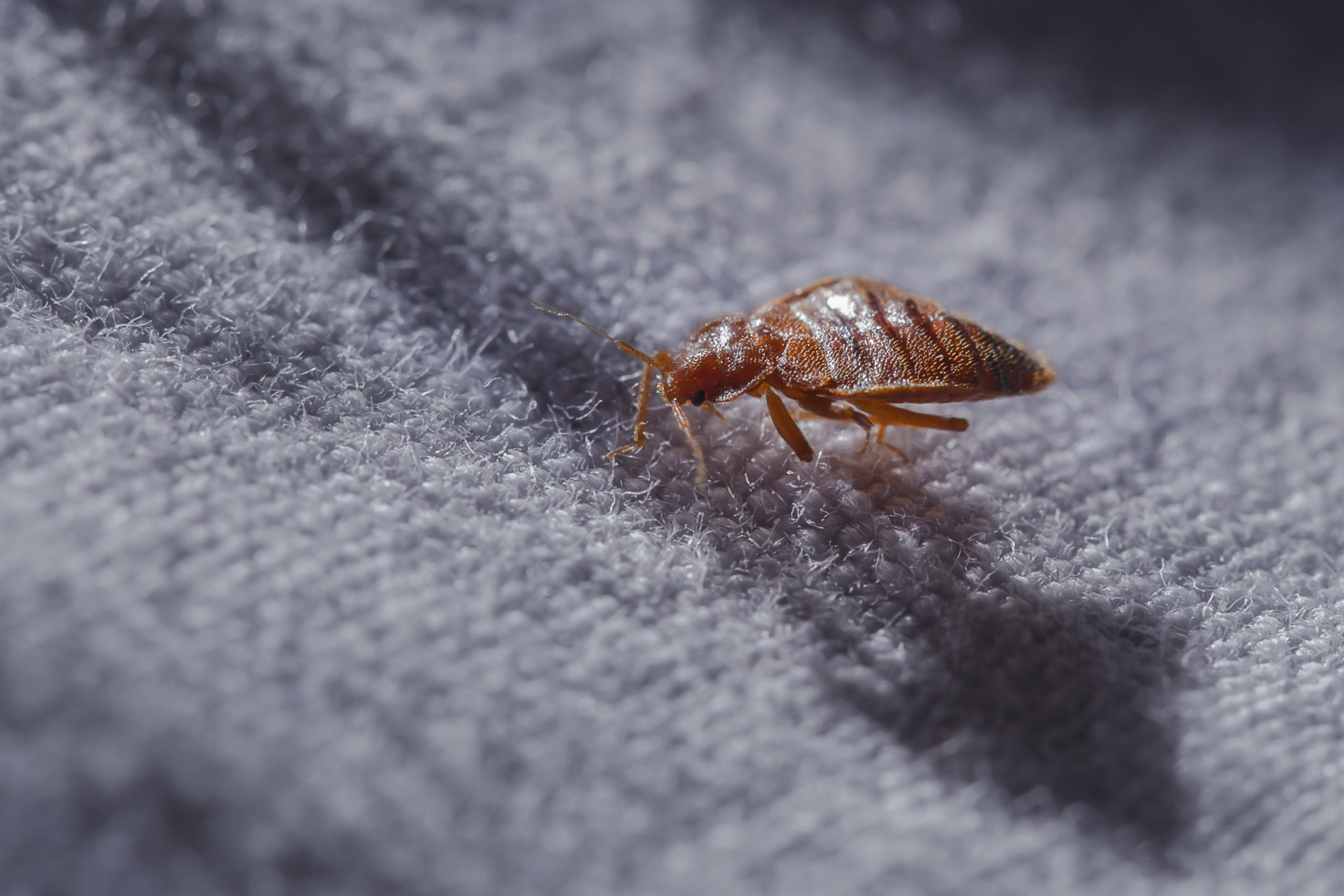
Yes, you read this right. Unfortunately, bed bugs do not stay confined to the bed where they are already a problem. They can be found in a multitude of places, like couches, wallpaper, office chairs, and curtain folds. Bed bugs will feed from both humans and pets, which both walk all over carpet. They only feed on exposed skin, so fortunately they can’t bite through clothing. You will definitely know if you have bed bugs because their bites are red, itchy, and clustered. Their color ranges from brown to purple-red, depending on if they have recently eaten. They are very small and stay hidden within carpet fibers, so you might not see them actively crawling around on the floor. They’re also nocturnal, hence why they are able to bite us at night, so they may not stay on the carpet for long.
The appeal of carpet for bed bugs is that they can lay their eggs in a corner where no one steps. Bed bugs favor crevices due to their limited access and proximity to a food source. The eggs hatch six to ten days after being laid, and the larvae begins to feed on mammals immediately. Since bed bugs live ten to twelve months, they can be a major problem for someone if these pests decide to stick around for a while. The easiest way to remove bed bugs from carpet is to vacuum the area extensively. It helps to use a vacuum with a bag or a very contained receptacle in order to prevent them from escaping. In the same way, a preventative measure to take is to keep the area vacuumed as often as you can. Bed bugs can’t live in a very clean fabric that is repeatedly disturbed by a vacuum, so it will help to ensure that you won’t be sharing your soft flooring with unwanted guests.
Carpet Beetles
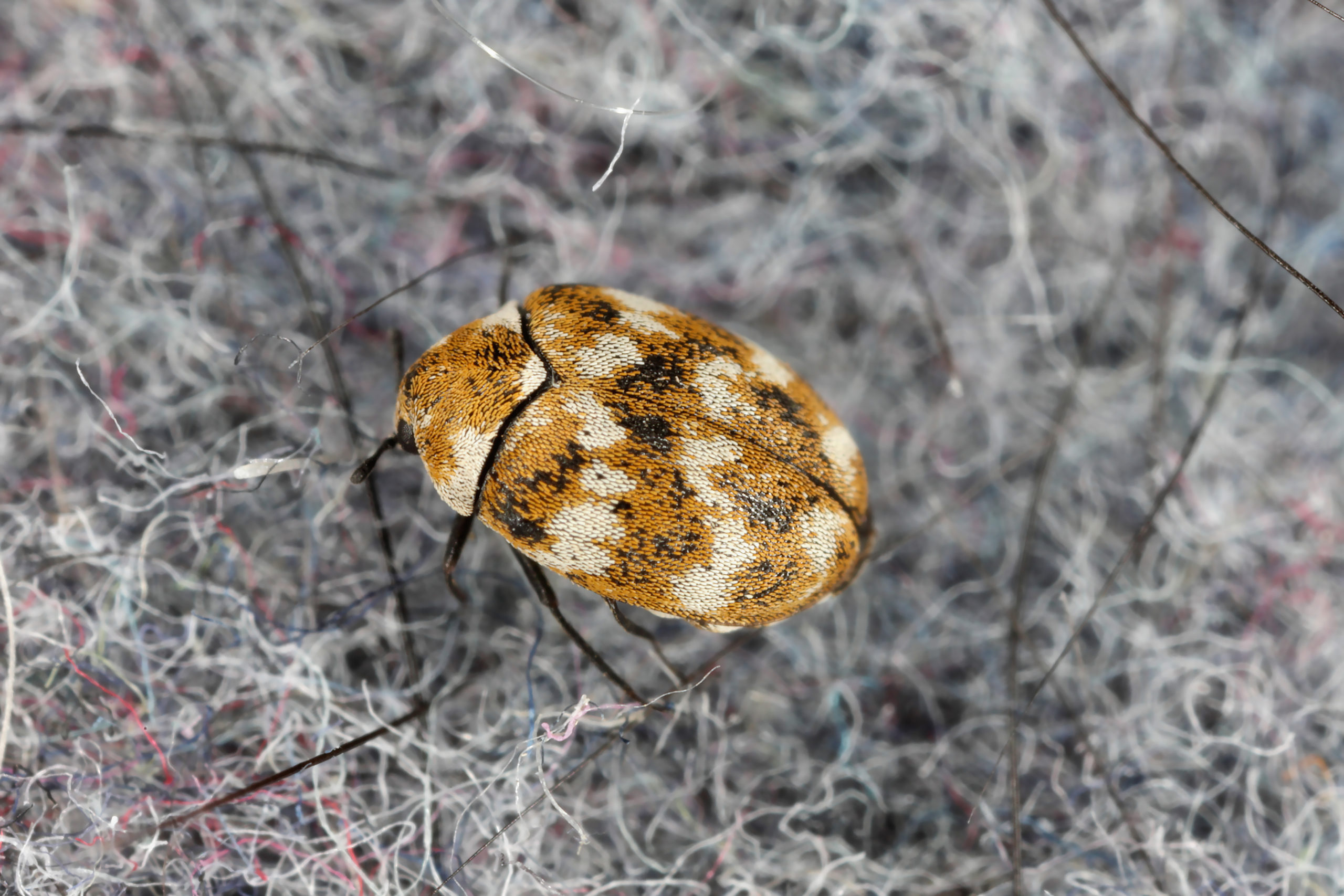
Carpet beetles are, predictably, one of the most popular carpet pests due to how many different things they can eat. But it may be surprising to learn that the larvae is the one that eats the materials found in carpet, not the adult beetles. The larvae eat all kinds of animal-products, including fur, flannel, wool, feathers, book bindings, dried foods, glue, leather, dead insects, and soiled synthetic materials. Adult beetles eat pollen and nectar from plants, which is a strange turn away from their namesake. There is one generation of beetles born every year, so at least we know that the large, hairy larvae is not terribly abundant in the home. A couple of signs that you may have carpet beetles is the sighting of shiny black beetles or discarded skin castes on the carpet. They are usually found near windows, probably trying to get outside to eat their beloved nectar. The larvae chews holes through fabrics, so small holes in your clothes is a likely sign of carpet beetles or another fabric-loving pest.
The ways that carpet beetles most frequently enter homes is either through hitching a ride on garden plants or thrifted clothing. Make sure to inspect any clothes and plants before bringing them home to make sure you aren’t introducing a new pest to your house. Carpet beetles can bite, but they don’t make it their main practice like bed bugs or fleas. This is another way to tell if you are actually dealing with carpet beetles; one person being bitten is likely a carpet beetle, while multiple people being bitten in one home is more along the lines of bed bugs. Carpet beetles are attracted to the carbon dioxide that we exhale, which may be why they bite on occasion. One easy way to prevent carpet beetles is to wash any affected clothes in hot water. Hot temperatures kill pests, so cleaning any affected or potentially affected clothing, bedsheets, and towels in hot water should do the trick. Since it takes about a year for carpet beetles to infest a home due to their limited egg-laying every year, it is ideal to take care of the problem as early as possible. These pests are definitely more visible than many of the others on this list, so it is possible to actually find them when you look.
Dust Mites
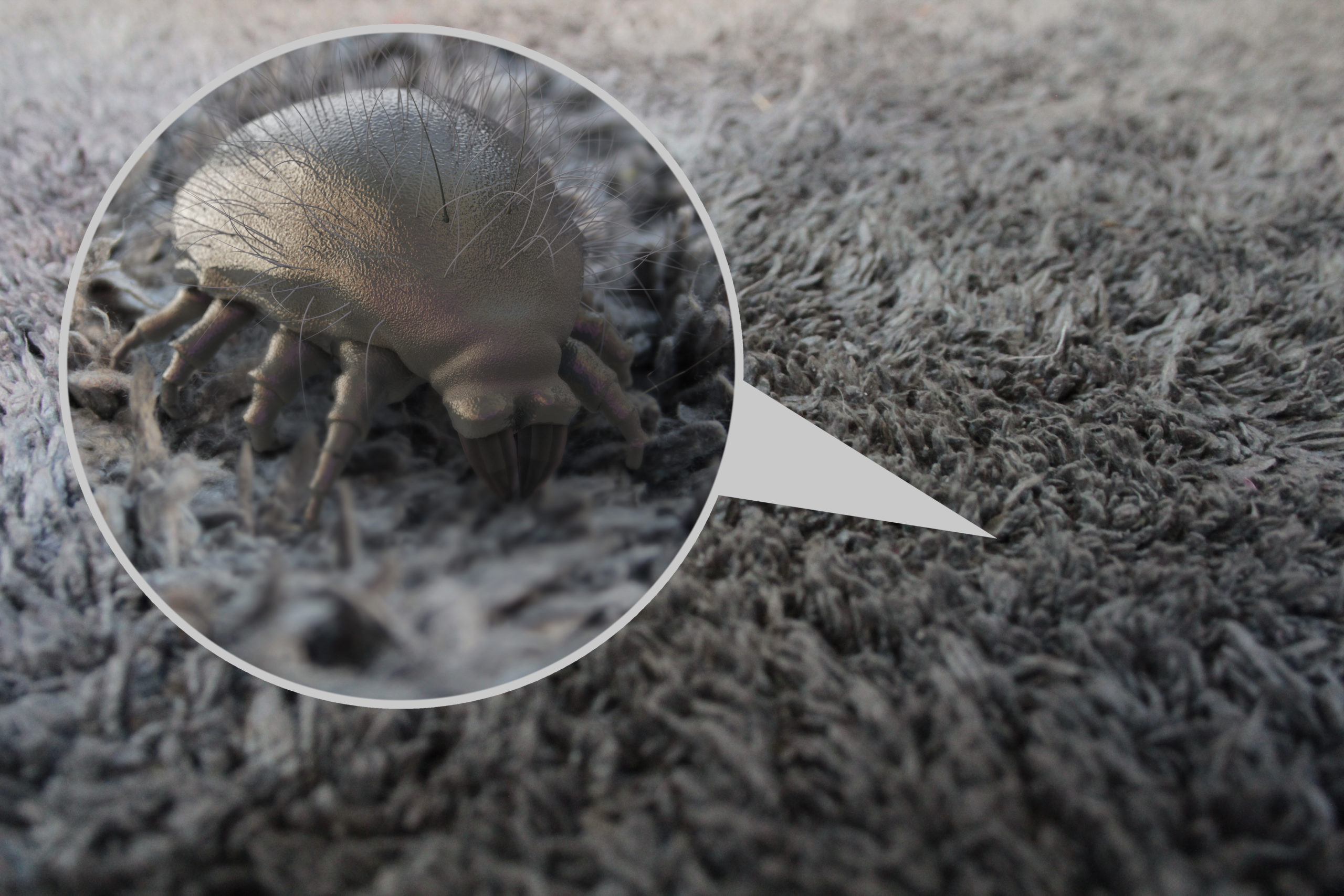
This is arguably the trickiest carpet pest out there. The main reason for this is simply because we can’t see them with our naked eye. You would need an estimated magnification of 10 just to see these microscopic mites. This is bad news considering the dust mite’s statistics. Their source of food is shed skin, which is abundant in a carpet-filled home just from us walking around every day. They favor carpet for this reason, but they can survive pretty much anywhere that dander exists. Some of the other common places dust mites live include a bed, upholstery, under the fridge, and near the dishwasher. They also favor pillows for the added moisture that our breath provides.
One of the scariest facets of dust mites is their ability for their abundant population to survive on minimal sustenance. Just one ounce of dust can support around 15,000 mites! So you can imagine just how much they have to choose from in a home with a lot of members living there. Dust mites also lay around 400 eggs every time, so there is no telling just how many there are living in an area at one time. Vacuuming the carpet regularly and steaming every so often will take care of the majority of the dust mite population. Also, wash the bed sheets every couple of weeks (or more frequently if you want) to make sure your bed is free of any pests disrupting your sleep. The easiest way for pests to stay in a home unnoticed is to stay in and under fabric that isn’t cleaned very frequently. This is because they are more likely to be undisturbed and have a constant source of food. You won’t see dust mites in your carpet without a strong magnifying glass, but keeping a clean home will help ensure that they won’t stay embedded in your soft flooring rent-free.
Fleas
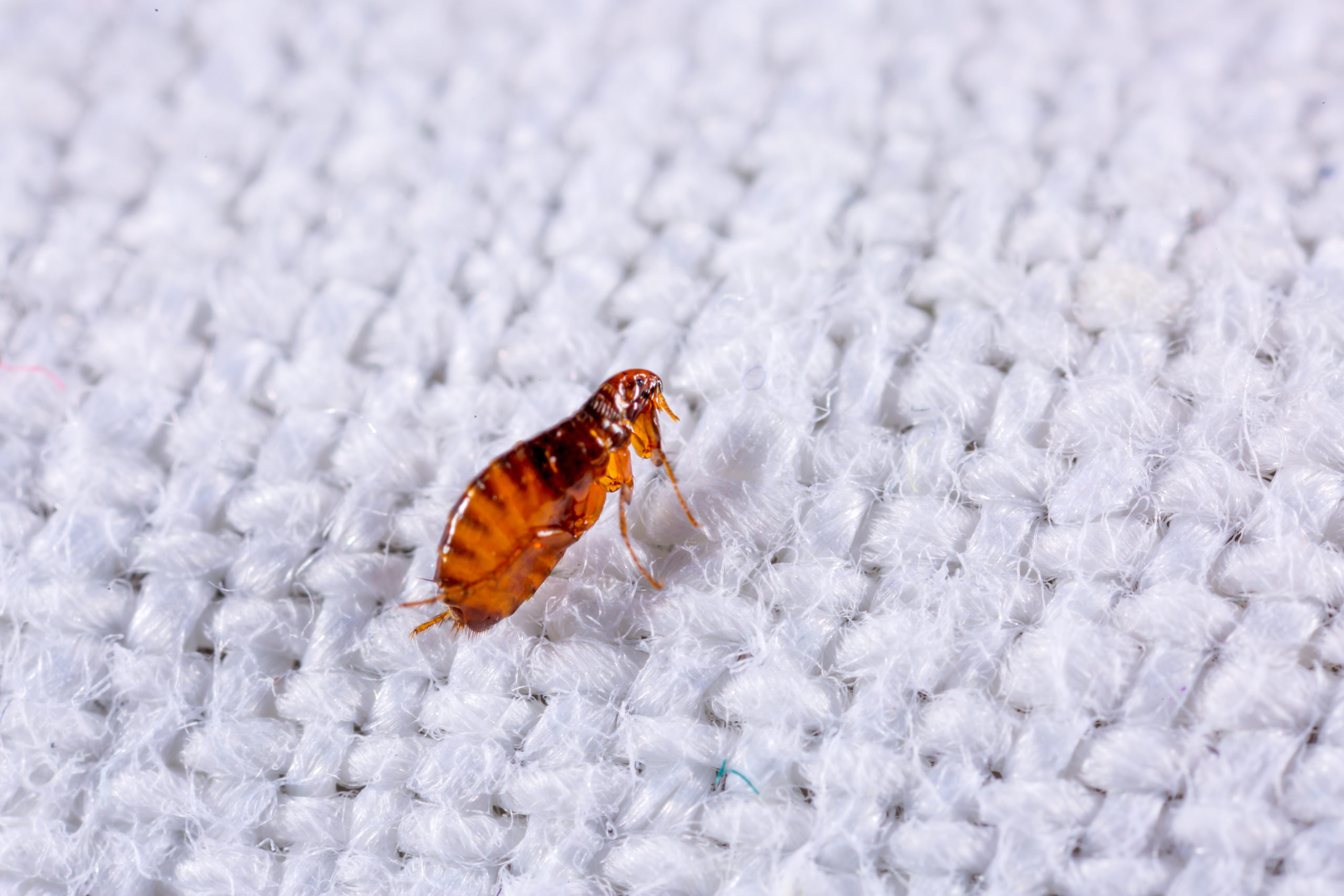
When we think of fleas, we typically think of a dog or cat furiously scratching its neck and ears. While this is a problem in and of itself, fleas can also live in other areas of the home in between living on a host. Carpet provides a hiding place while a flea waits for an innocent mammal to pass by, which they will then jump onto. Lying on the floor will not attract fleas, but it will be very inviting if they are already present in the home. Fleas need blood to reproduce, so the good news is that they will quickly die off or leave if there is no source of warm blood. Flea bites are incredibly itchy on both pets and people, and can cause pet hair loss on your furry friend if they stick around long enough. Another unfortunate potential effect of flea bites is anemia, which is the lack of healthy red blood cells since fleas feed upon those. They can also be carriers of multiple diseases, including three different types of plagues. So it is very important to take care of a flea problem as soon as possible in order to hopefully avoid these effects.
If you believe your pet has fleas or is very susceptible to them, it may help to bathe them semi-frequently. This will wash away any blood-sucking pests that latch onto the pet’s fur. They bite and then lay eggs on the host, so a small flea problem will quickly turn into a massive irritation if it’s not taken care of soon. As for the carpet, vacuuming and steaming will be your best bet in this instance. It will clean up any fleas stranded on the floor, as well as cleanse the floor of any dust, pet and human dander, and hair that pests love so much. Plus, who doesn’t love the feeling of walking on clean carpet?
Silverfish
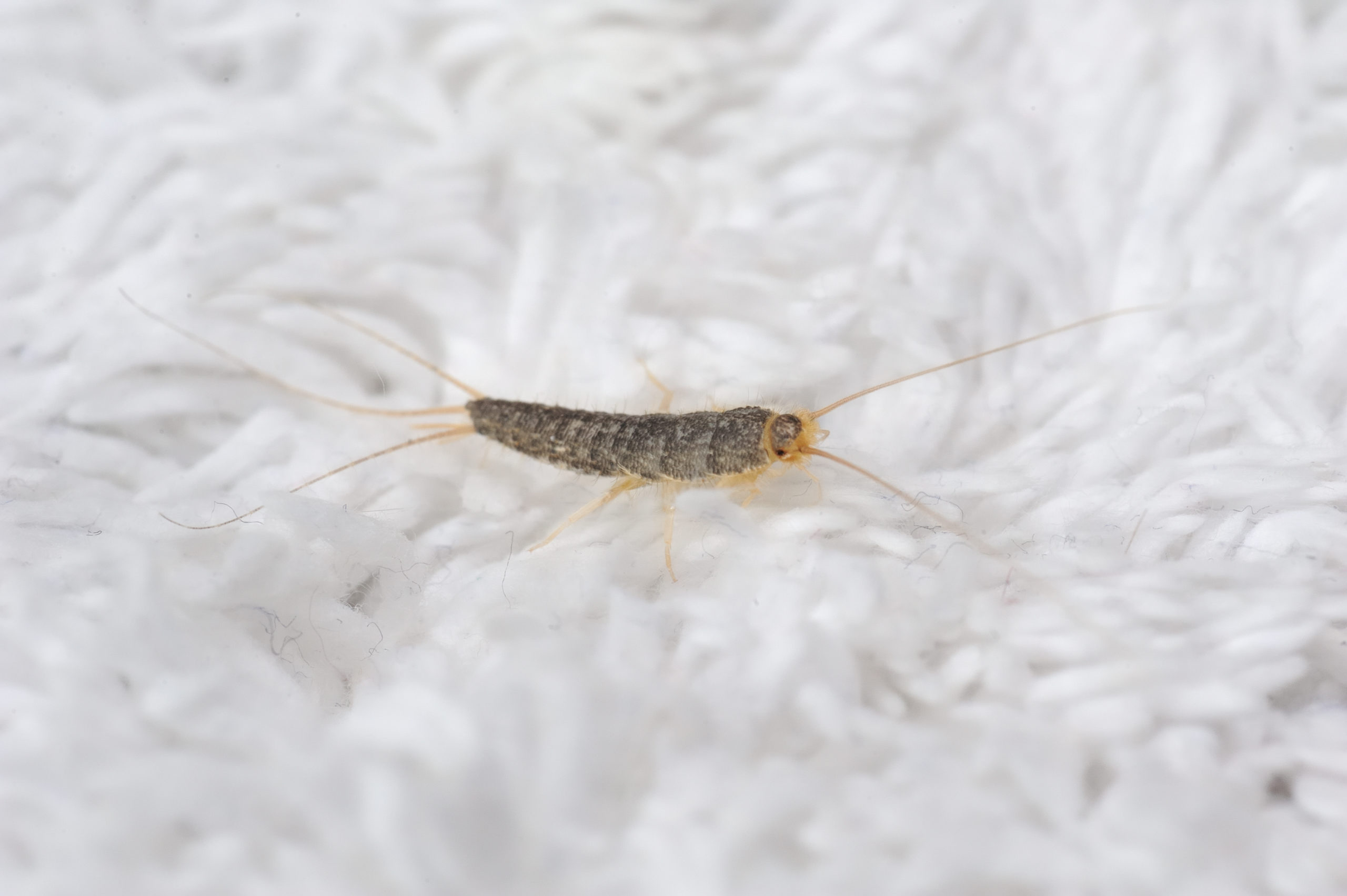
This creepy pest is known for its silvery appearance and long body. Silverfish eat basically any kind of material that is high in protein, sugar, and starch. Some of their favorite foods are paper and paste, and really anything that has those materials in them. Silverfish are attracted to carpet because of the natural fiber content, and wool carpet in particular is at risk of a silverfish infestation. They want moisture, which can be easily trapped in carpet that has people and pets repeatedly walking and laying on it. If the humidity level is high in the house, there is likely to be a silverfish problem.
The annoying part of having silverfish in your home is how good they are at hiding for being shiny insects. Their eggs are left in the darkest and moistest areas of the home, which is why they often stay in the bathroom. But in search of food, silverfish may venture out to the carpeted areas for their favorite meals. There are a few easy ways to prevent silverfish from getting comfortable on your carpet. One is to vacuum, similar to how you would prevent other pests. By keeping a vacuumed carpet, we eliminate the sources of food for many pests. It gets rid of the protein and starch that silverfish crave. Also, moth balls work against silverfish even though they didn’t get the privilege of being in the name. You could hide a couple of moth balls in corners of the carpeted room that they seem to love the most. Silverfish spend a lot of time in closets too, due to the animal fibers from the clothing and carpeting. If you store blankets or thick coats in the closet, it might help to keep them in the large plastic bags that can be vacuum-sealed or zip-closed at the top. Holes in your carpet or clothing are not something you need in life, so silverfish aren’t a good houseguest to keep around after they decide to invade.
Pest Control is Carpet’s Best Friend
Although these small pests seem scary due to their abundance and lack of visibility, pest control is always a viable option to be sure that your carpets are free from pests. Contact our team today to learn more about how we can use our EPA-approved products to eradicate the pests without bringing harmful chemicals into your home. Carpet is for lounging and relaxing with your family and pets, not for pests to live in and establish their colonies.
Citations
Crawley, S. & Bertone, M. (2021, June 14). Clothes moths and carpet beetles: Identifying and controlling fabric pests. NC State Extension. Available at https://content.ces.ncsu.edu/clothes-moths-carpet-beetles-controlling-fabric-pests (Accessed on April 27, 2022).
Identifying and controlling clothes moths, carpet beetles and silverfish. (2022, March 22). Department of Primary Industries and Regional Development. Retrieved April 27, 2022, from https://www.agric.wa.gov.au/pest-insects/identifying-and-controlling-clothes-moths-carpet-beetles-and-silver%EF%AC%81sh
Pritchard, E.L. (2022, March 2022). Carpet beetles: Signs you have an infestation and how to get rid of them. Country Living. Available at https://www.countryliving.com/uk/homes-interiors/interiors/a35477258/carpet-beetles/ (Accessed on April 27, 2022).
What’s living in your carpet?. (n.d.). Commercial Steam Team. Retrieved April 27, 2022, from https://commercialsteamteam.com/whats-living-inside-carpet/
Request a Free Quote Today
(We do not share your data with anybody, and only use it for its intended purpose)


